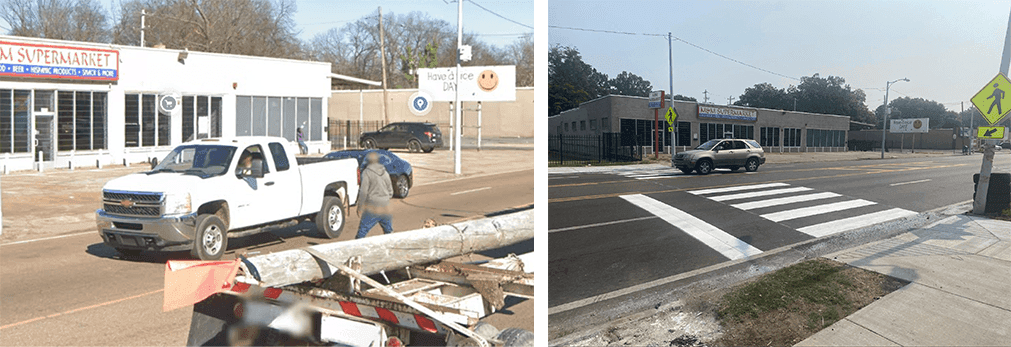
News
By Eric Cova, March 20, 2024
The City of Memphis passed a Complete Streets plan in 2019 to make their streets safer, building on an earlier 2013 policy. But the plan's non-binding nature combined with the lack of dedicated funding and support produced significant challenges in implementing the policy. Their participation in the Complete Streets Leadership Academy armed them with more methods and partnerships to make safe streets a reality. Read the full case study in the Complete Streets Leadership Academies Report and explore the other case studies here.
Project Snapshot
The Memphis project location was selected because it is a hub for people walking and biking, with two transit stops nearby. Even with a lack of safe infrastructure, an average of 30.5 pedestrians and cyclists cross this roadway per hour, meaning someone crosses at least every two minutes. Between 2020 and 2022, six pedestrians and cyclists were hit while trying to cross the street. Two people were seriously injured, and four people were killed.
The City of Memphis already has a Complete Streets plan for this area, created by TDOT, but that plan hasn’t been implemented yet. Their quick-build project followed the existing draft plans but utilized temporary materials. In doing so, Memphis was able to test out how the design would function so that any needed changes could be made in advance of a permanent installation.
The Memphis quick-build demonstration project took place on Summer Avenue between Tillman Street and Baltic Street. To provide pedestrians and cyclists with a safer place to cross the five-lane roadway, the City of Memphis worked with TDOT to add a striped crosswalk, providing more visibility to the crossing. They also installed pedestrian crossing signs with a flashing LED light that alerts drivers and placed an “island” made of flex curb and cold mix asphalt in the center lane to calm traffic and reduce conflict points. The City of Memphis helped add ADA-compliant curb ramps so that more people would be able to use the crosswalk safely, regardless of how they travel.
Outcomes
The impact of the project was measured through observations, data collection, and engagement. Highlights include:
- Engagement throughout the quick-build demonstration built confidence among community members in TDOT’s plan for permanent change.
- During the quick-build project, city staff were stationed onsite to talk to community members. Links to an online survey were advertised throughout the city so that people could easily provide feedback on the project and whether or not it made them feel safe. This also produced increased knowledge and awareness of the issue among community members.
Key Takeaways
Internal capacity is essential to success. There were staffing issues within the City of Memphis team that impacted the quick-build project’s road to implementation. When plans for Summer Avenue were first put in motion, three people were working together on the city’s Bikeway Pedestrian Program. By the end of the project, only one staff member remained. While the project was ultimately successful, there were some aspects of the project that needed to be set aside as internal capacity dwindled.
Barriers will arise—but they don’t have to stop a project in its tracks. Originally, the Memphis team planned to involve an artist to draw attention to the demonstration project using bright colors along the sidewalks of Summer Avenue. However, their artist had a scheduling issue that made this portion of the project difficult to accomplish. Though the final version of their quick-build project didn’t fully match their original vision, the Memphis team continued moving forward and still took valuable steps toward building strong partnerships and paving the way for permanent change.
 In 2022, Smart Growth America launched the Complete Streets Leadership Academies in Alaska, California, Connecticut, and Tennessee to equip and train local agencies and state departments of transportation to collaborate, innovate, and commit to making changes together to address safety on these dangerous state-owned roads. Cohorts were selected to plan and implement "quick-build" demonstration projects, a way to pilot and test new ideas and street designs to activate streets and better support walking, biking, and rolling.
In 2022, Smart Growth America launched the Complete Streets Leadership Academies in Alaska, California, Connecticut, and Tennessee to equip and train local agencies and state departments of transportation to collaborate, innovate, and commit to making changes together to address safety on these dangerous state-owned roads. Cohorts were selected to plan and implement "quick-build" demonstration projects, a way to pilot and test new ideas and street designs to activate streets and better support walking, biking, and rolling.This program and report was developed with funding from the Centers for Disease Control and Prevention’s (CDC) Division of Nutrition, Physical Activity, and Obesity (Cooperative Agreement CDC-RFA-OT18-1802). The views presented in this product do not necessarily reflect the views and/or positions of CDC.
Related News

© 2025 Smart Growth America. All rights reserved
Site By3Lane Marketing


















